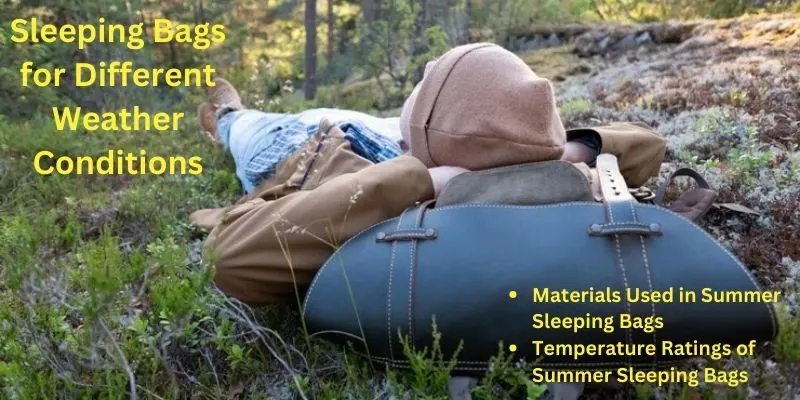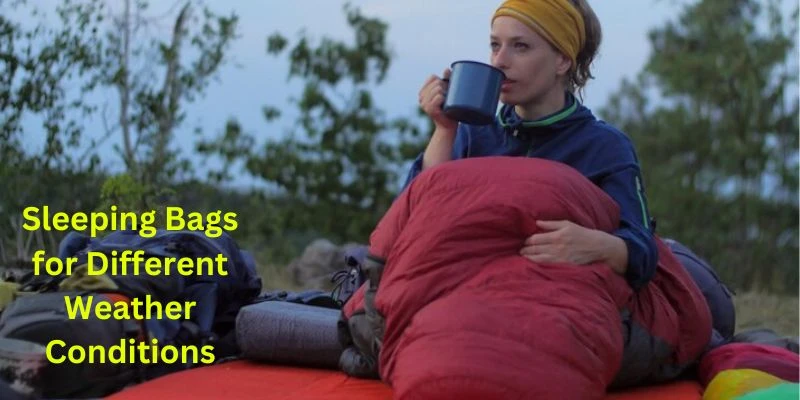Discover the 6 Top Sleeping Bags for Different Weather Conditions: Your Ultimate Guide!
Updated: 2 Mar 2024
201
Choosing the right sleeping bag can make or break your outdoor adventure. Whether you’re summer camping under the stars, braving the cold of winter expeditions, or preparing for all-season escapades, your sleeping bag is your ultimate partner in comfort and survival. This guide, tailored for outdoor enthusiasts, campers, and hikers, dives into the top-rated sleeping bags suited for varying weather conditions.
Sleeping Bags for Different Weather Conditions
Regarding sleeping bags, it’s crucial to consider the weather conditions you’ll face during your camping trip. For cold-weather camping, look for sleeping bags with lower temperature ratings and insulation to keep you warm throughout the night. Insulated sleeping bags with features like draft tubes and hoods can help trap heat and prevent cold air from seeping in.
On the other hand, for warmer-weather camping, opt for sleeping bags with lighter insulation and breathable materials to prevent overheating. Additionally, consider the sleeping bag’s size and weight for ease of transport, especially if you’ll be backpacking or hiking to your campsite.
Planning a trip to Pawna Lake? Ensure your comfort with the right sleeping bag for different weather conditions. Choosing the appropriate sleeping bag from chilly nights to warmer days will make your Pawna Lake camping experience and enjoyable.
By choosing the right sleeping bag for the weather conditions, you can ensure a comfortable and restful night’s sleep under the stars.
Summer Sleeping Bags For Camping
Features of Summer Sleeping Bags For Camping
Summer sleeping bags are designed to keep you cool, dry, and comfortable during warm weather conditions. They typically come in lightweight and compact designs, making them ideal for backpacking trips where weight and space are crucial factors.
Certainly, here are the features of summer sleeping bags for Best Camping and Destiantions:
- Lightweight and compact design for easy portability.
- Breathable materials to enhance airflow and ventilation.
- Comfortable temperature rating typically above freezing (e.g., 35°F or higher).
- Minimal insulation to prevent overheating in warm weather.
- Built-in pillow or detachable hood for added comfort.
- Zippered foot vent for temperature regulation.
- Durable construction to withstand outdoor use.
- Water-resistant or quick-drying outer shell to repel moisture.
- Compression sack for convenient storage and transportation.
- Compatibility with sleeping pads for additional comfort.
These sleeping bags also offer excellent ventilation and breathability, ensuring you stay dry even on hot and humid nights.

Materials Used in Summer Sleeping Bags
Most summer sleeping bags are made with synthetic materials, such as polyester and nylon, for their quick-drying properties. These materials also provide excellent moisture-wicking capabilities to keep you cool and dry throughout the night. Some summer sleeping bags may also have a mesh lining for added ventilation.
Temperature Ratings of Summer Sleeping Bags
This table outlines the temperature ratings for summer sleeping bags, indicating their comfort rating, lower limit rating, and suitable temperature range.
| Sleeping Bag Type | Comfort Rating | Lower Limit Rating | Suitable Temperature Range |
| Summer | 35°F (1.7°C) | 25°F (-3.9°C) | Above freezing |
Extra Features of Summer Sleeping Bags
- Summer sleeping bags often feature lightweight and compact designs for easy portability.
- Additional features like a built-in pillow or detachable hood may enhance comfort during use.
- Certain models may include a zippered foot vent to assist in regulating body temperature.
These extra features contribute significantly to ensuring a comfortable sleeping experience in various conditions.
Marmot NanoWave 55
For those who seek adventure during the warm summer nights, the Marmot NanoWave 55 is a standout. Praised for its breathability and ultra-lightweight design, it ensures that those mild nights remain blissfully comfortable without overheating.
The North Face Eco Trail
The North Face Eco Trail is also tailored for the summer camper. Its eco-friendly design combines sustainability with comfort, making it an excellent choice for nature lovers. With superb ventilation, it promises cool and restful nights outdoors camping.
Winter Sleeping Bags for Camping
Features of Winter Sleeping Bags For Camping
Winter sleeping bags are designed to keep you warm and insulated in freezing temperatures. They are typically heavier and larger than summer sleeping bags, but their added warmth is essential for surviving harsh weather conditions. Most winter sleeping bags also come with a hood to protect your head from the cold.
Sure, here are the features of winter sleeping bags for camping:
- Insulation and hood for warmth in cold conditions.
- Draft collar or zipper baffle to prevent cold air from entering.
- Interior pockets for storing essentials, keeping them warm and accessible.
- Durable and weather-resistant materials to withstand harsh winter conditions.
- Compression sack for compact storage and easy transportation.
- Water-resistant or waterproof outer shell to protect against moisture.
- Zippered vents for temperature regulation.
- Compatibility with sleeping pads for added insulation and comfort.
- Temperature rating suitable for frigid weather conditions.
- Reflective elements for increased visibility in low light conditions.
Materials used in Winter Sleeping Bags
To withstand extreme cold, winter sleeping bags are often made with down or synthetic insulation. Down is a natural insulator that provides an excellent warmth-to-weight ratio, while synthetic insulation is more affordable and retains its insulating properties even when wet. Some winter sleeping bags may also have a waterproof outer shell to protect against moisture.
Temperature Ratings of Winter Sleeping Bags
This table summarizes the temperature ratings and suitability of winter sleeping bags for frigid weather conditions. Additionally, it highlights the variability in temperature ratings among brands and individuals, emphasizing the importance of testing the sleeping bag in different conditions.
| Sleeping Bag Type | Temperature Rating | Suitable Temperature Range | Additional Information |
| Winter | 20°F (-6.7°C) | Frigid conditions | Temperature ratings can vary between brands and individuals’ body temperatures. Testing in various conditions is advisable. |
Extra Features of Winter Sleeping Bags
- Winter sleeping bags typically feature insulation and a hood to provide warmth in cold conditions.
- Additional features like a draft collar or zipper baffle help prevent cold air from entering the sleeping bag, enhancing insulation.
- Some models may include interior pockets for storing small essentials, keeping them warm and readily accessible.
These extra features play a crucial role in ensuring warmth and comfort during winter camping expeditions.
Western Mountaineering Kodiak MF
When temperatures plummet, the Western Mountaineering Kodiak MF steps up. Renowned for its warmth and plush comfort in frigid conditions, it’s described by experienced campers as “a true winter essential.”
NEMO Sonic -20
Braving extreme cold is no challenge for the NEMO Sonic -20. Its innovative design and exceptional insulation keep adventurers warm in conditions as low as -20°F (-29°C). Its thermal efficiency has garnered praise for providing a haven in the harshest of winter environments.

All-Season Sleeping Bags
Features of All-Season Sleeping Bags
- Designed to be used in a variety of weather conditions, including spring, summer, and fall.
- Versatile temperature ratings, usually ranging from 0 to 30 degrees Fahrenheit.
- Available in both down and synthetic insulation options for different needs and preferences.
- Often have additional features such as adjustable hoods, draft collars, and zipper baffles for improved comfort.
- Generally more compact and lightweight compared to winter sleeping bags, making them a great option for backpackers and hikers.
- Can be used for both camping and indoor sleepovers, making them a versatile investment.
- Some all-season sleeping bags also come with the option of being zipped together to create a double bag for couples or families.
Sierra Designs Cloud 800
Versatility is key for the all-season adventurer, and the Sierra Designs Cloud 800 delivers just that. A favorite among hikers, it shines with its lightweight construction and adaptable warmth. “Its versatility and light weight make it a standout among all-season sleeping bags,” says one hiking enthusiast.
REI Co-op Magma 30
The REI Co-op Magma 30 is heralded for its blend of high-quality insulation and durability. “With its durable design, the REI Co-op Magma 30 is a reliable choice for campers and hikers,” states an expert. It caters to a wide range of temperatures, making it a solid all-season option.
Comparison of Features
These sleeping bags stand out for their insulation type, temperature rating, weight, and packability, catering specifically to the needs of the outdoor enthusiast. From the ultralight Marmot NanoWave 55, ideal for backpackers, to the warmth and resilience of the Western Mountaineering Kodiak MF for winter warriors, each offers unique benefits. The all-season Sierra Designs Cloud 800 and REI Co-op Magma 30 offer flexibility without the bulk, perfect for those who trek through varying climates.
Audience Consideration
For the outdoor enthusiast, camper, or hiker, these sleeping bags represent the pinnacle of market offerings. Carefully selected based on performance, durability, and comfort, they promise to enhance your connection with nature, ensuring safety and comfort throughout your journeys.
Conclusion
Investing in a high-quality sleeping bag tailored to the weather conditions and your personal needs is essential for a comfortable and enjoyable outdoor experience. Whether you’re gazing at the stars on a summer night, facing the fierce cold of winter, or preparing for the unpredictability of shoulder seasons, equip yourself with a sleeping bag that meets your demands.
Remember, “the right sleeping bag not only offers comfort but also protection against the elements.” Embark on your next adventure with confidence, knowing you have the best gear to keep you cozy and secure, no matter where your travels take you.
FAQs
What types of sleeping bags are suitable for different weather conditions?
Sleeping bags come in various types such as summer, three-season, and winter bags. Summer bags are lightweight with minimal insulation, suitable for warm weather. Three-season bags offer versatility for spring, summer, and fall, while winter bags are designed for colder temperatures with heavier insulation.
How do I choose the right sleeping bag for my camping trip?
Consider factors like temperature rating, insulation type, weight, and size. Choose a sleeping bag with a temperature rating appropriate for the weather conditions you’ll encounter. Insulation type (down or synthetic) affects performance and price. Select a bag that fits your body size and weight preferences for optimal comfort.
What is the difference between a mummy and a rectangular sleeping bag?
Mummy sleeping bags have a tapered design that wraps closely around the body, minimizing air space to retain warmth efficiently. Rectangular bags offer more room for movement but may not be as thermally efficient. Choose based on your preference for warmth versus space and comfort.
How do I properly maintain and store my sleeping bag?
Follow the manufacturer’s instructions for cleaning and storing your sleeping bag. Air out your bag after each use to prevent odors and moisture buildup. Store it loosely in a large sack or hang it in a cool, dry place to maintain loft and insulation properties.
Can I use the same sleeping bag for different weather conditions?
While some sleeping bags are versatile enough to use across seasons, it’s essential to match your bag’s temperature rating with the conditions you’ll face. Layering clothing inside your bag can help adjust to varying temperatures, but it’s best to have a bag specifically suited for each weather condition for optimal comfort and safety.
How can I extend the lifespan of my sleeping bag?
Handle your sleeping bag with care to prevent tears or damage to the fabric and insulation. Use a sleeping pad to provide additional insulation and protect the bottom of the bag. Avoid over-compressing your bag during storage, and periodically fluff it up to maintain loft. Regularly clean and air out your sleeping bag to prevent odor and mildew buildup.
Please Write Your Comments